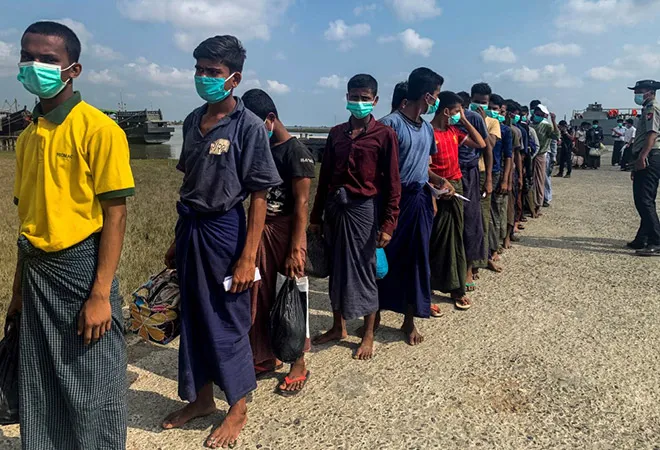-
CENTRES
Progammes & Centres
Location

Last week, the Bangladesh government made it quite apparent that they won’t allow the displaced Rohingyas from neighbouring Myanmar, quarantined at Bhasan Char, to shift to the camp areas in the Cox’s Bazar region. They want the refugees to stay in the char region. The displaced people fear that they will be made to live there until they are repatriated to Myanmar.
More than 300 displaced Rohingyas were rescued by the Bangladesh navy in early May after being stranded at sea for more than two months, not being able to enter either Malaysia or Thailand due to Covid-19 scare. Following international pressure, Bangladesh became obliged to provide shelter.
However, the new arrivals were sent to Bhasan Char, a landmass made up of silts. This particular landmass is located at the northern end of the Bay of Bengal and the mouth of the Ganges-Brahmaputra-Meghna river system. It will be in the first area of impact if a tsunami or cyclone hits the region. Bangladesh, as is known, takes big hits by cyclones, year after year.
Bhasan Char was chosen under the initial strategy of Bangladesh -- Ashrayan 3. It was planned to move the Rohingyas there. Nevertheless, since a UN team is yet to declare the place fit for habitation after technically assessing it, the plan to move the Rohingyas in December 2019 was halted.
In February 2020, there were rumours that the land will not be provided to the Rohingyas anymore and will be made available to Bangladeshi citizens in need. However, with the current state of events, it seems that Covid-19 has become a good pretext for test-running the government’s pilot scheme since the spread of the disease remains too high within the camp areas.
More than two months in sea with less food, water and dreadful surroundings, the people rescued are malnourished, dehydrated and overwhelmed. They have fear in their eyes and are in need of proper nourishment, care and protection. However, the accounts of their interviews are unleashing a diverse scenario.
Barring the instability of the place in face of major storm or cyclone, the government had stated in its report that there is abundance of food and clean water at Bhasan char. Nonetheless, current interviews with the displaced people show that they are getting minuscule meal just two times a day and if they ask for more, they are verbally abused. There is also dearth of clean drinking water which questions the government plan.
The people have stated that they are facing serious medical problems after being stranded at sea for months, but proper medication as well as care is absent. Only paracetamol tablets are being provided and specialised medicines for either communicable disease like diarrhoea and dysentery, or non-communicable diseases like diabetes and high blood pressure, are lacking.
There is apprehension regarding women and girls who may have encountered sexual or other form of brutality while they were on the boat or since. Absence of counselling and treatment for such instances puts them in deeper emotional and physical barriers.
It is unclear how many medical professionals or nurses are stationed within the Char land. It was initially also confirmed by the government that if anyone within the area faces any major health emergency, facilities within the Char land is not sufficient. Thus, they will have been to be taken to hospital in the Hatiya Island, which is around three hours boat ride. This again questions the planning and reliability of governmental arrangements.
If one looks at the promises made by the Bangladesh government, then one of the pre-requisites for the shifting to take place was positive will of the displaced people themselves to live on in such a place. However, presently there are reports of threats being made by the officials to the hapless people stating that they will not be able to go back to the camp areas. They have also stated that their families may be called in to join them.
Finally, the security aspect remains vulnerable. To avoid security threat within the islet from outside as well as inside, several facilities like watch tower, perimeter fencing along with police posts is built. The government has past experience of deteriorated law and order situations in the camps located at Teknaf and Ukhiya which are filled with crimes like theft, murder, drugs and human trafficking as well as gender-based crimes.
To ensure that such occurrences come down, security cameras will be installed so that action and movement of the people can be continuously monitored. Nonetheless, such a situation positions these people as culprits rather than as victims. Restrictions on movement will remain due to geography and their position as displaced people will isolate them further.
Amidst the aforesaid measures and steps taken by the government, few questions still remain unanswered regarding maintenance of law and order at Bhasan Char. For instance, the kind of custodial action that will be taken if any person commits crime within the islet or if the people within are harmed by any outside entity. Also, in case of police mistreatments or custodial sexual abuses or killings, in what way such situations will be dealt or what sort of action will prevail remain unclear.
Such situations are occurring currently where the displaced people have described officers punishing them either physically or verbally. They have made women stand in hot sun for few hours since they spoke on mobile phone which is prohibited. It is important to understand that these people have already faced injustice and abuse at the hands of people in uniform within Myanmar, thus repeating acts of injustice makes trusting similar people in a different land extremely difficult.
Bangladesh needs to re-evaluate its strategy to deal with the current circumstances since the situation back home is quite disturbing due to the rising cases of COVID. Thus, proper instructions need to be laid out to the officials to deal with the displaced people with compassion and care while they live in the Bhasan Char area. Proper food and medicines need to be arranged if there is a shortage. Few sections of humanitarian organisations may be allowed entry at Bhasan Char to ease some tensions at the moment.
While Bangladesh has shouldered very weighty responsibilities towards the displaced people, the major focus is remaining on their repatriation to Myanmar. The humanitarian partners in this regard have a major role to play. The condition within Myanmar is highly unfit for any repatriation procedure to take place in the near future. However consistent efforts and funding are required to make it a reality.
In this regard, the Myanmar Humanitarian Response Plan 2020 is designed (HRP) through the most inclusive inter-sectoral analysis of humanitarian needs in Myanmar till date. Based on a broad consultative process, that incorporated extensive and appropriate discussions with government, the current framework is shaped.
It focuses to address the needs and priorities of all communities in the region with the support of the government. However, the activities have been impacted by the fighting between the Arakan Army and Tatmadaw and the current COVID situation. Yet, efforts are necessary to create conducive environment and an addendum to the HRP 2020 has been published on 17 July to counter this situation. However, implementation of written words remains the key.
On a long term basis there is a need to relax restrictions on freedom of movement, greater access to income generating activities and generating a lucid way to the citizenship question. Political will in this regard will be essential for a positive outcome to these solutions.
While the current COVID situation is taking a toll on member states yet ignoring the displaced or internally displaced population in need may not resolve anything but may create far reaching negative effect in near future. Thus, proper steps are essential to counter the situation.
The views expressed above belong to the author(s). ORF research and analyses now available on Telegram! Click here to access our curated content — blogs, longforms and interviews.

Sreeparna Banerjee is an Associate Fellow in the Strategic Studies Programme. Her work focuses on the geopolitical and strategic affairs concerning two Southeast Asian countries, namely ...
Read More +